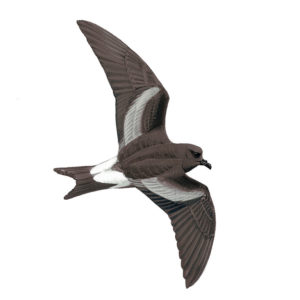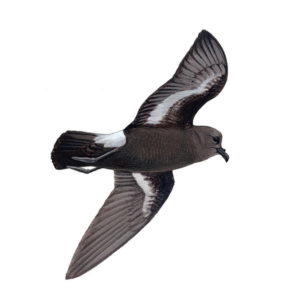On 29 June 1983, Paul James and Hugh Robertson were researching petrel sounds on Selvagem Grande in the Selvagens when they heard some calls of an unfamiliar storm petrel. It certainly was not a Madeiran Storm Petrel Oceanodroma castro or a White-faced Storm Petrel Pelagodroma marina, both of which breed there in large numbers. They relocated it on several nights, calling from the same site in a collapsed stone wall (CD2-65). At 23:20 on 8 July, an all-dark storm petrel was caught in a nest chamber containing twigs and plant fragments, just like ones being used by Madeirans in the same wall.
The mystery petrel differed from its neighbours not only in lacking a white ‘rump’; it also had a more deeply forked tail, a different bill shape and pale bases to the primary shafts. After a visit to the skin collection of the British Museum of Natural History at Tring, England, the observers became convinced that they had seen a Swinhoe’s Storm Petrel O monorhis, the first ever for the Atlantic Ocean (James & Robertson 1985a).
CD2-65: Swinhoe’s Storm Petrel Oceanodroma monorhis Selvagem Grande, Selvagens, 29 June 1983. Purring of a male, ending with a chatter call, the first Swinhoe’s to be discovered in the Atlantic Ocean. Paul James.
Prior to this discovery, Swinhoe’s Storm Petrel was only known from islands off China, Japan, South Korea and the Russian Far East. During the non-breeding season it migrates to the Indian Ocean, reaching the eastern coast of Africa (Bailey 1968, van den Berg et al 1991, Brooke 2004). On 14 January 1958, one flew up the Red Sea as far as Eilat in the Gulf of Aqaba, making it onto the Western Palearctic list (Cramp & Simmons 1977). Before 1983, however, Swinhoe’s was not known to have visited the western side of Africa, let alone islands that are politically a part of Europe.
For several years, the record from Selvagem Grande remained a freak, one-off occurrence. Then in 1988, a second male was caught prospecting in a different wall. Like the first, it was measured, ringed, photographed and sound-recorded (Bretagnolle et al 1991). A third was captured by Frank Zino on 23 July 1991. He had been putting up nets all over the island, playing the 1983 recording, only to find one in a wall just five metres from his bedroom. Like the others, this bird was visiting a potential nest site, and it had a very vascularised brood patch, suggestive of breeding. In the summer of 1993, Paulo Moniz caught a fourth, one-legged individual at a section of a collapsed wall. Unfortunately he had no ring to put on it. The next summer, however, Frank trapped a one-legged Swinhoe’s at the same spot and ringed it. He trapped it again in 1995 and 1996. Two of its capture dates were right at the end of August, surprisingly late for a non-breeder. But if it was a breeder, where was its partner?
During the exceptionally warm summer of 1989, there was a dramatic development when Swinhoe’s Storm Petrels appeared much further to the north. On 19 July, an unidentified large storm petrel was seen and heard calling above a trapping area at Tynemouth, England, where ringers were playing a British Storm Petrel Hydrobates pelagicus tape lure. Over the following week, two different dark-rumped storm petrels were trapped at the same site (Carruthers et al 1989). The same month, a male was trapped twice in a mist net on Banneg, Brétagne, which has the largest British Storm Petrel colony in France (Bretagnolle et al 1991). A year later, a particularly obliging female became the third individual trapped at Tynemouth. She was recaptured no less than seven times over the next four years (Morrison 1998). On 31 July 1991, her chatter calls were sound-recorded, and a blood sample was taken for DNA analysis (Dawson 1992). Since then, further individuals have been mist-netted in Ireland (one), mainland Portugal (one), Scotland (one) and Norway (three). Surprisingly, three individuals have also been trapped in the Mediterranean, two mist-netted at storm petrel colonies in Spain, and one captured sick at Genoa, Italy. The identity of these birds as Swinhoe’s has been resolved thanks to a combination of biometrics, genetics, plumage and sounds (Cubitt et al 1992). Several probable Swinhoe’s have been observed at sea and from boats and from land (Morrison 1998), although a fully documented, undisputed sight record is still a major prize waiting to be claimed.
The latest and most surprising twist in the tale occurred just as this book was being completed. On 30 August 2007 I received an email from Rafael Matias. He had been working on a Cory’s Shearwater Calonectris borealis project on Selvagem Grande, and spent a total of nearly two months on the island, starting in May. At 01:10 on 19 August, Rafael heard an odd storm petrel calling in the area where Frank Zino had told him that the one-legged Swinhoe’s Storm Petrel had been trapped four times in the mid-1990s. In the strong wind, he was unable to work out quite where the sound was coming from. Two nights later, he heard it again three times around midnight, managing to locate it from the third call. After waiting an hour and hearing no more calls, he left a tape recorder running and continued with his fieldwork. Then on returning at 02:40, he heard the storm petrel clambering up inside the wall. Just as it was about to escape, he was delighted to catch a two-legged Swinhoe’s bearing a Portuguese ring. Rafael processed and documented it thoroughly. From his sound recordings, we were able to confirm later that it was a male. He also took measurements, a blood sample and a series of photographs. The final shot, taken just before it disappeared back into its burrow, is shown opposite. A month later, Rafael heard an additional two female Swinhoe’s on the island. One, at the exact spot where he had captured the male, may well have been the one-legged bird captured during the 1990s, although this could not be confirmed. The other was heard calling in flight over the island’s central plateau.
Rafael, Frank and I were on the edge of our seats as we waited for news about the male’s ring. When the news came, it blew our minds. The bird recaptured on 21 August 2007 was the very same one that Paul James had ringed on 8 July 1983, the first for the Atlantic. The bird you can see in the photograph from 2007 is the one that you can hear in CD2-65, recorded in 1983. By the time of its recapture, this bird was at least 25 years old.
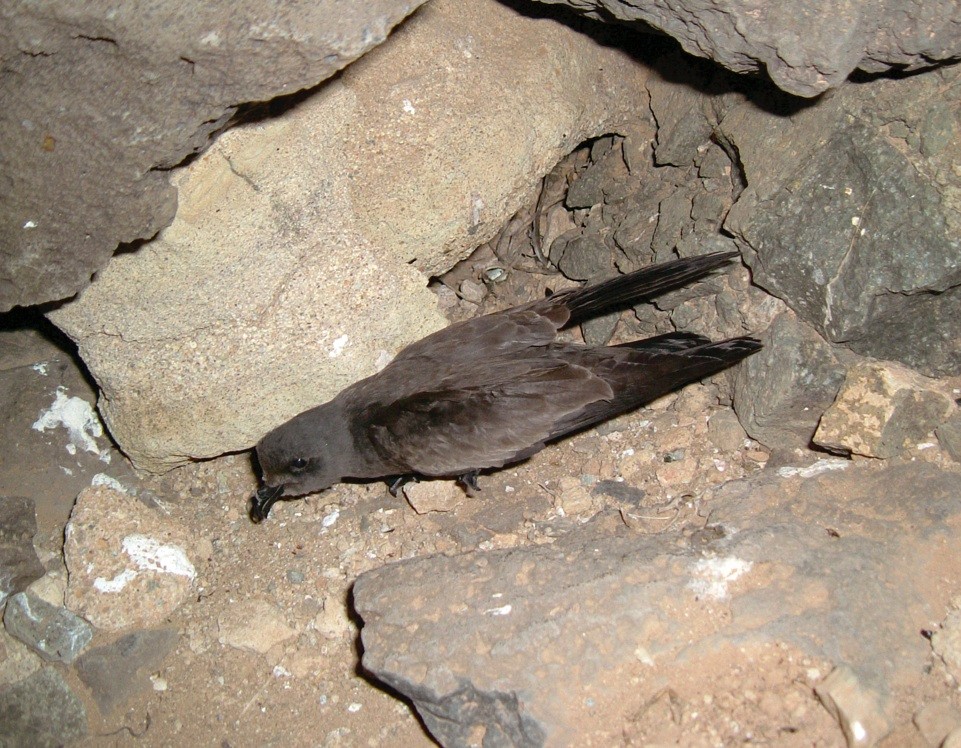
Swinhoe’s Storm Petrel Oceanodroma monorhis, Selvagem Grande, Selvagens, 21 August 2007 (Rafael Matias). This is the very same individual as in CD2-65, which was recorded 24 years previously!
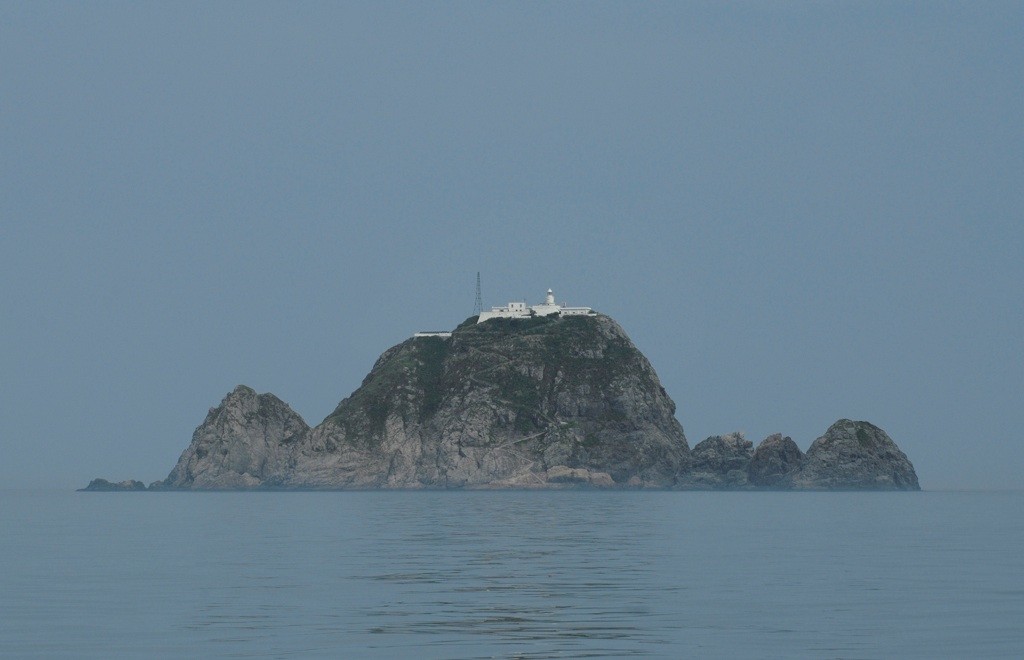
Chilbaldo, South Korea, 20 June 2007 (René Pop). CD2-66 to CD2-70 were recorded here.
Two months earlier, Arnoud van den Berg and René Pop visited the Swinhoe’s Storm Petrel colony on the islet of Chilbaldo in South Korea. At just four hectares, Chilbaldo is tiny. It lies in the Yellow Sea (34°47’N / 125°47’E), about 45 km from the south-western Korean mainland and 10 km from the nearest large island of Bigeumdo. There are just a few stunted trees, and the lush vegetation consists of a variety of grasses. Lee Ki-sup, who brought Arnoud and René to the islet, believes that the cover provided by a type of sedge Carex, as well as the absence of rats, makes Chilbaldo particularly attractive for storm petrels. Around 7900 pairs of Swinhoe’s are thought to breed on the islet, making it the second largest known Korean colony. Lee Ki-sup estimates there are at least 10 times as many pairs on Guguldo, about 100 km to the south-west.
No ornithologist had been to Chilbaldo for a long time, and Lee Ki-sup had not visited it since he was a PhD student more than 15 years ago. The day he brought Arnoud and René to the islet was hot, and the long, winding concrete pathway up to the lighthouse looked daunting. There was a lot to be carried up, because they had taken the precaution of bringing enough food for a week. As they staggered up with their heavy loads, they started seeing dead birds on the steps. These included some seabirds, such as the odd Swinhoe’s and an adult Ancient Murrelet Synthliboramphus antiquus, but most were migrants that had succumbed on their journey north. Among the remains that could be identified were a Little Cuckoo Cuculus poliocephalus, a Green-headed Wagtail Motacilla taivana, a Black-naped Oriole Oriolus chinensis and a Grey Starling Sturnus cineraceus. A bright blue wing and severed head were all that remained of a Fairy Pitta Pitta nympha, one of Korea’s shyest forest birds. They did not have to look far for the culprit: a Peregrine Falcon Falco peregrinus was perched on a nearby rock. The resident pair had chosen their territory well, and thanks to a constant stream of migrants throughout the spring, they had brought up at least two young. Now the family were terrifying the island’s resident summer birds, including Blue Rock Thrushes Monticola solitarius, several rare Pleske’s Grasshopper Warblers Locustella pleskei and a family of Brown Shrikes Lanius cristatus. Even during daytime, sporadic chatter calls of Swinhoe’s Storm Petrels could be heard on either side of the path, answering one another from burrows under the sedge.
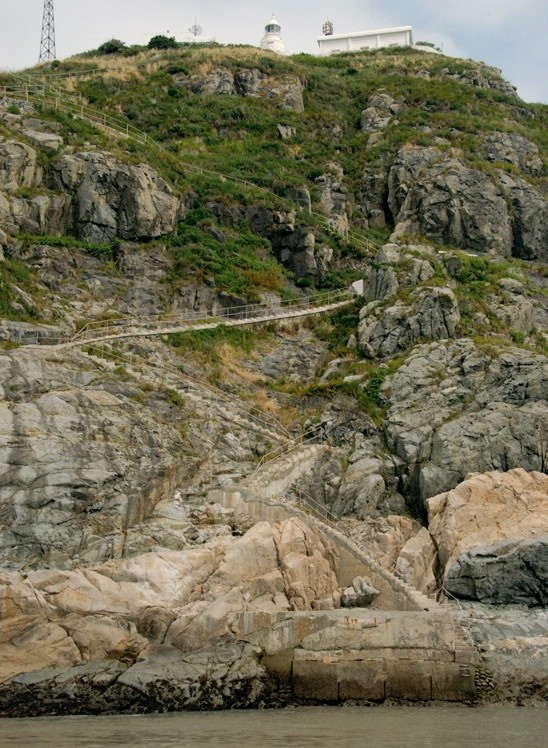
Winding stairway leading from landing platform to the lighthouse, Chilbaldo, South Korea, 22 June 2007 (Arnoud B van den Berg).
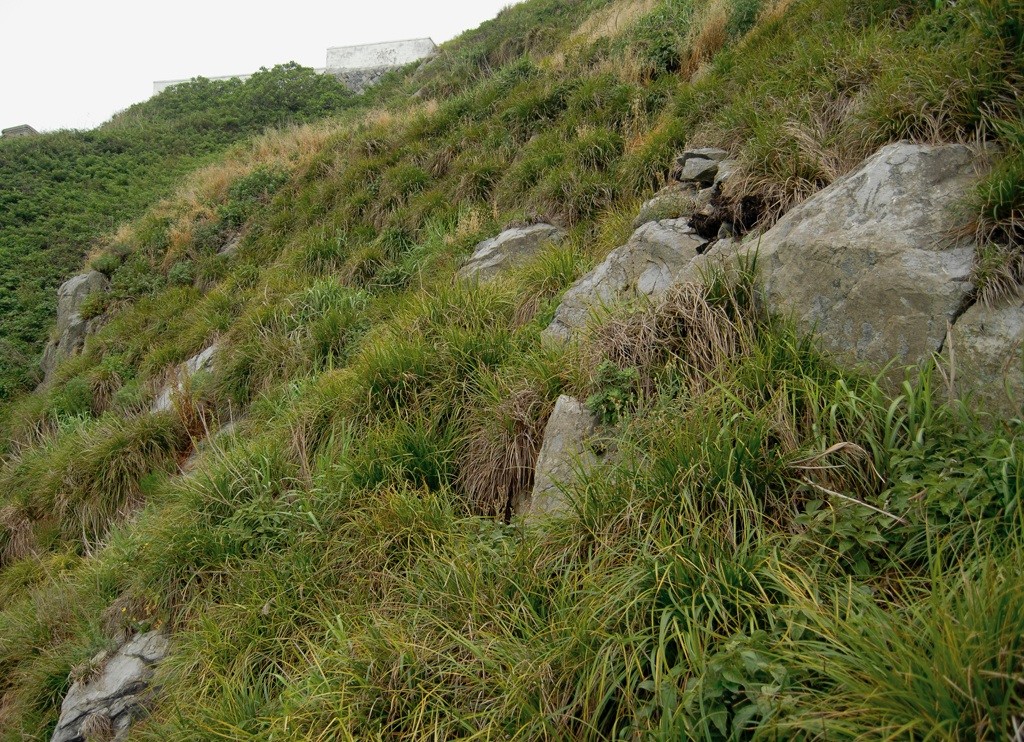
Tussocks of sedge Carex on steep slopes, Chilbaldo, South Korea, 22 June 2007 (René Pop). The breeding habitat of Swinhoe’s Storm Petrel Oceanodroma monorhis.
Not long after the Fork-tailed Swifts Apus pacificus had screamed their evening chorus, the Swinhoe’s Storm Petrels began to steal the show. Their chatter-calling rose in a great crescendo, and they continued calling throughout the night. CD2-66 was recorded during a peak of storm petrel aerial activity about an hour before it became light, by which time the pre-dawn chorus of Streaked Shearwaters C leucomelas was also underway. Male Streaked have incredibly high-pitched, two-note whistles (eg, 0:37-0:44), while females (eg, 0:45-0:51) sound much like female Cape Verde Shearwaters C edwardsii, but with shorter notes and a faster delivery.
CD2-66: Swinhoe’s Storm Petrel Oceanodroma monorhis Chilbaldo, Jeollanam-do, South Korea, 03:38, 21 June 2007. Massed chatter calls of males and females, calling both in the air and from the ground. Background: Streaked Shearwaters Calonectris leucomelas. 07.024.AB.10203.11
Chatter calls of Swinhoe’s Storm Petrel are quite different from those of Madeiran Storm Petrel, but they share their overall structure with Leach’s Storm Petrel O leucorhoa. In both Swinhoe’s and Leach’s, there is an acceleration towards the end, reminiscent of a bouncing ball. Whereas in Leach’s the ball loses energy and comes to rest on the floor, in Swinhoe’s it seems to defy gravity and end up on the ceiling. In other words, Swinhoe’s chatter calls end with a series of short notes, rising in pitch and volume towards the end. The call as a whole has more notes, including an extra rising one in the middle, entirely lacking in Leach’s. There are typically more than 12 notes in total, compared to just nine or so in Leach’s.
The voice of Swinhoe’s Storm Petrel is as strange among petrels as the plumage of the Dotterel Charadrius morinellus is among waders, because the usual sexual dimorphism is reversed. Male Swinhoe’s (CD2-67) are the ones with harsh chatter calls and females (CD2-68) have bright, clear chatter calls with harmonics (Taoka et al 1989c). This is the exact opposite of what you find in, say, band-rumped storm petrels Oceanodroma and most shearwaters Calonectris and Puffinus. In Leach’s Storm Petrel, both sexes usually have clear-sounding chatter calls (although either sex can sound a bit harsh) and instead, the sexual difference has to do with fundamental frequency. Although male and female Swinhoe’s sound very different in timbre, the rhythmic pattern is the same in both. There are no consistent sexual differences in the number of notes, although in males, most notes average significantly longer (Taoka & Okumura 1990).
Unlike waders with sexually reversed plumages, there are no obvious differences between the mating systems of Swinhoe’s and Leach’s Storm Petrels, although further research might lead to their discovery. Both species use their chatter calls in two main contexts (Taoka et al 1989a, 1989c). Males typically call from their burrows to attract females, while females call from the air to elicit responses from males. This is what was going on in the preceding recording, CD2-66. The other main context in which chatter calls can be heard is aggressive exchanges between members of the same sex, and this can be heard in CD2-67 and CD2-68.
CD2-67: Swinhoe’s Storm Petrel Oceanodroma monorhis Chilbaldo, Jeollanam-do, South Korea, 22:13, 20 June 2007. An exchange of chatter calls between males in their burrows, also eliciting responses from flying females at, eg, 0:09 and 0:22. Male screech calls can also be heard. 07.023.AB.05254a.21
CD2-68: Swinhoe’s Storm Petrel Oceanodroma monorhis Chilbaldo, Jeollanam-do, South Korea, 03:42, 21 June 2007. Chatter calls exchanged between females in neighbouring burrows. Background: occasional male Swinhoe’s calls and both male and female Streaked Shearwaters Calonectris leucomelas.
070621.AB.034236.01
Quite why there should have been selection for harsh calls in male Swinhoe’s Storm Petrel and clear calls in females is a complete mystery. Harsh calls in petrels are thought to be cryptic, like dull plumages, and it is thought that they are usually found in females, because females do more of their calling in the air, putting them at a greater risk of predation. Clear calls with harmonics are more conspicuous and allow more scope for individual variation. In most species this is thought to be advantageous for males, helping them to advertise their individual burrows. At the same time, being safely hidden in a burrow releases them from the need for a cryptic signal (Storey 1984). It may be significant that male Swinhoe’s are much smaller than females, perhaps making them more vulnerable to predation, while male and female Leach’s are the same size (Brooke 2004). On the other hand, there is no evidence for greater predation in Swinhoe’s colonies compared to Leach’s. If anything, there may be less. On Chilbaldo, for example, there were no gulls, and judging by their prey remains the Peregrines seemed to be more interested in catching passerine migrants than storm petrels, rather like Eleonora’s Falcons F eleonorae in the Western Palearctic.
Purring calls of Swinhoe’s Storm Petrel are similar to those of Leach’s Storm Petrel, with a rising, wheezing breath note at regular intervals. The breath note is usually much longer in Swinhoe’s, and this would be one of the best ways to locate a Swinhoe’s, should one ever turn up in a colony of Leach’s. Purring calls of male and female Swinhoe’s can be told apart quite easily. In male Swinhoe’s, there is a loud, harsh accented note immediately following the breath note, while in females the equivalent note is clear with harmonics. CD2-69 starts with a male Swinhoe’s purring on its own. At 0:09, he is interrupted by a chatter call from his mate. He responds in kind and then they purr together, their phrases somewhat out of sync.
CD2-69: Swinhoe’s Storm Petrel Oceanodroma monorhis Chilbaldo, Jeollanam-do, South Korea, 21:37, 20 June 2007. Purring of a pair in their burrow, with chatter calls from time to time. Background: chatter and purring calls of other individuals. 07.023.AB.01710.11

Swinhoe’s Storm Petrel Oceanodroma monorhis, Chilbaldo, South Korea, 20 June 2007 (René Pop). At entrance of nest hole along stairway, at night.
As in Leach’s Storm Petrel, purring is typically heard when both pair members are in the burrow, before the female has laid an egg. More often than not, it is just the male that purrs, although the female often interrupts with chatter calls (Taoka et al 1989c). In South Korea, Swinhoe’s Storm Petrels lay in early July, and by the end of the month, very little purring can be heard. Chatter calling dies down over the same period, and during incubation, Swinhoe’s is a rather quiet bird (Taoka et al 1989c).
Besides chatter calls and purring, Arnoud recorded various other calls, many of which were variants of a harsh, single note call. These are aggressive signals, equivalent to the screech calls of Leach’s Storm Petrel. In male Swinhoe’s Storm Petrel, screech calls often alternate with chatter calls, and both call types have a similarly harsh timbre. There seems to be a higher prevalence of screech calls in Swinhoe’s compared to Leach’s, at least when comparing Arnoud’s recordings of Swinhoe’s from Chilbaldo to mine of Leach’s from Iceland. Might Swinhoe’s be a more aggressive species, with male chatter calls that have evolved to become harsher and more like its screech calls? In CD2-70, several males can be heard giving both call types in a rather heated interaction.
CD2-70: Swinhoe’s Storm Petrel Oceanodroma monorhis Chilbaldo, Jeollanam-do, South Korea, 21:21, 20 June 2007. Two males exchange screech calls and chatter calls at the start. Then from 0:33, a male and a female purr together. After 2:05, the female continues purring while the male gives chatter calls and screech calls. 07.023.AB.00123.21
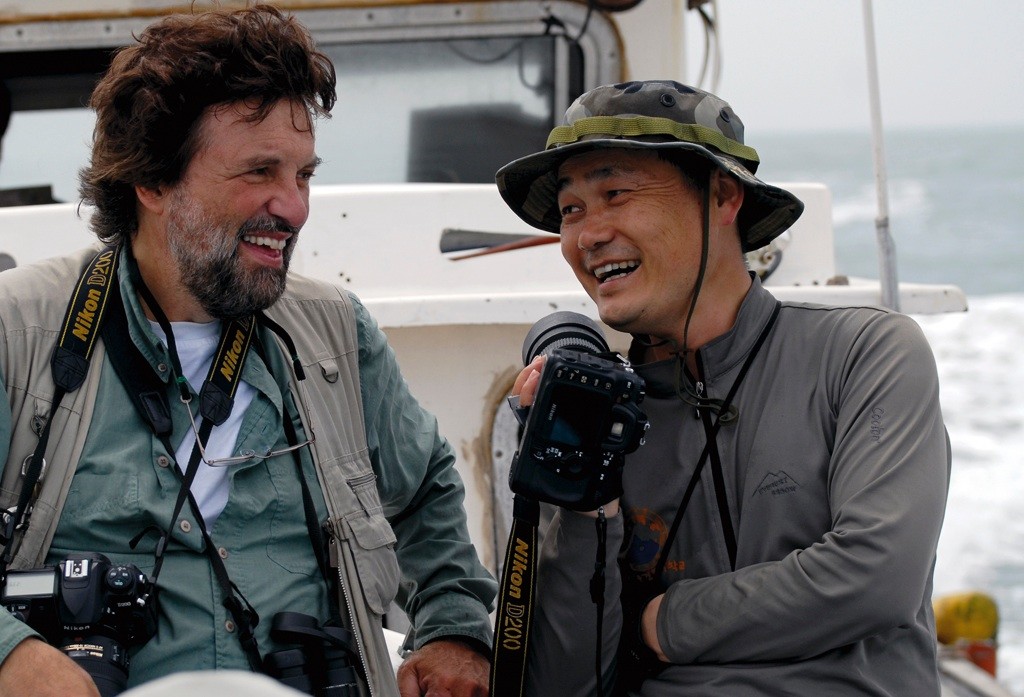
Arnoud van den Berg (left) and Lee Ki-sup on the way back from Chilbaldo, South Korea, 22 June 2007 (René Pop)
Today, the question whether a population of Swinhoe’s Storm Petrels might breed somewhere in the North Atlantic remains one of the greatest seabird mysteries. In 1991, DNA samples were taken from individuals trapped at Tynemouth and Selvagem Grande and when these were examined, no significant differences between Atlantic and Pacific Swinhoe’s could be found. So we can safely dismiss the idea that Atlantic birds belong to an ancient and long-established lineage of their own. Either we are just dealing with a series of vagrants, or there may be an Atlantic breeding population that has only recently become established. An old description of a dark-rumped, fork-tailed storm petrel from the Desertas, unearthed by Bourne (1990), suggests that Swinhoe’s have been around since at least 1829.
When I looked at the dates of confirmed records from the north- eastern Atlantic, all concerning trapped birds, I found that there was a gradual northward movement through the summer. The earliest Swinhoe’s to date have been captured during the last week of June in the Selvagens and Portugal. This is significantly earlier than the three records from the Mediterranean (13 July to 13 August), suggesting that an arrival via the Middle East is unlikely. The earliest date from further north is 1 July on Skellig Michael, Ireland, but 62% of captures in Britain, France and Ireland have occurred during the last 10 days of July. Four of the five in Norway have occurred during the first half of August. Clearly, your chances of finding a Swinhoe’s peak later the further north and east you go.
A possible explanation for this northward movement is the gradual rise in sea temperatures during the course of the summer. As I write this paragraph it is 11 July 2007. Surfing the internet, I find that the current sea surface temperature around Chilbaldo is 24° C. At the most northerly Swinhoe’s Storm Petrel breeding station in the Verkhovsky islands, Russia, the sea temperature is 17° C. In the eastern Atlantic, temperatures in this range are currently to be found from the Cape Verde Islands to the Bay of Biscay. There are also temperatures of 17° C or above in some shallow coastal areas further to the north, as far as northern England and southern Scandinavia.
North Atlantic surface temperatures peak around mid-August and it seems no coincidence to me that the most northerly records of Swinhoe’s have occurred around this time. On 13 August 2006, one was even captured north of the Arctic Circle, on Røst in the Lofoten islands. Swinhoe’s Storm Petrel’s preference for a certain range of sea temperatures has nothing to do with comfort, and presumably everything to do with food. Unfortunately, we know next to nothing about what they eat
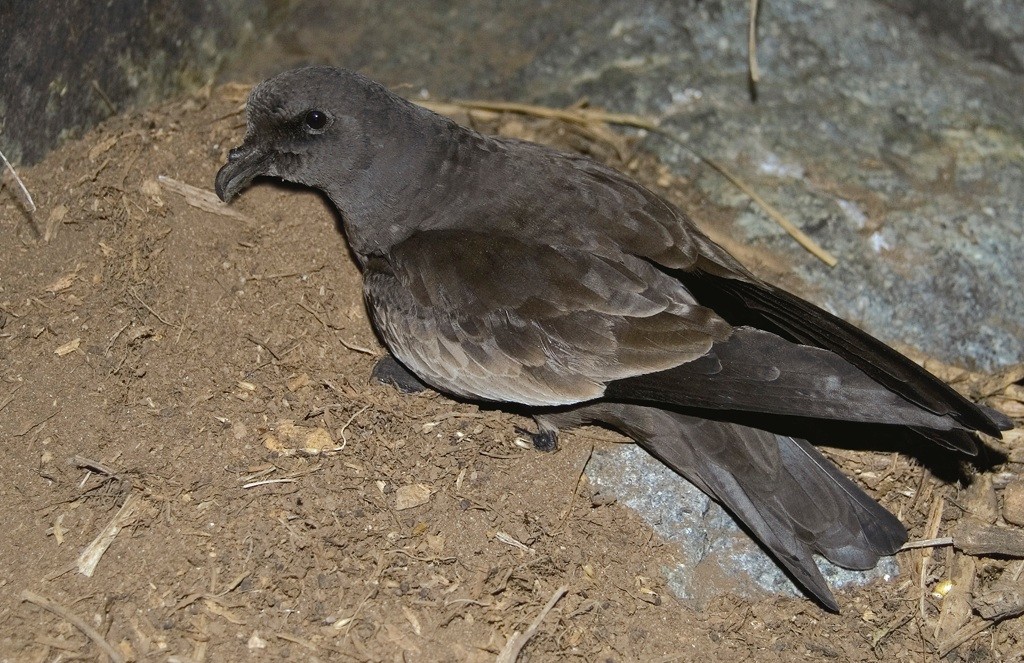
Swinhoe’s Storm Petrel Oceanodroma monorhis, Chilbaldo, South Korea, 20 June 2007 (René Pop). At night, beside stairway.
Lee Ki-sup has examined stomach contents and found that they eat shrimps and a species of anchovy. This is not much to go on, especially the shrimp, species of which occur throughout all marine ecosystems. On the other hand, anchovy are primarily coastal fish. In the Atlantic, Swinhoe’s could find them along coastlines all the way from South Africa to southern Norway, and that fits in nicely with a little notion of mine.
It seems remarkable that so many storm petrels, including the odd Swinhoe’s, can be trapped at places like Tynemouth where you would rarely see them during the day. To me this suggests that it is quite normal for certain storm petrels to fly close to the shore at night. Recent research in the Algarve, Portugal, has given some insight into why they might do this. Despite large storm petrel populations in the Azores, Berlengas, Madeira and the Selvagens, no British Storm Petrels are known to breed in Portugal. Nevertheless, many migrants are mist-netted each year by a team working at coastal sites in the south of the country. The same team also trapped a Swinhoe’s on 27 June 1998. By collecting vomit samples of mist-netted British, Thomas et al (2006) have been able to identify some of the tiny creatures they feed on. Prominent among these have been Eurydice naylori and E affinis, two species of sea lice that burrow into the sand during the daytime, but come out to feed in the surf at night. My hunch is that Swinhoe’s may also regularly feed close to the shore at night. How else could a surprising number of them be trapped at sites where even a Leach’s Storm Petrel would be a cause for jubilation?
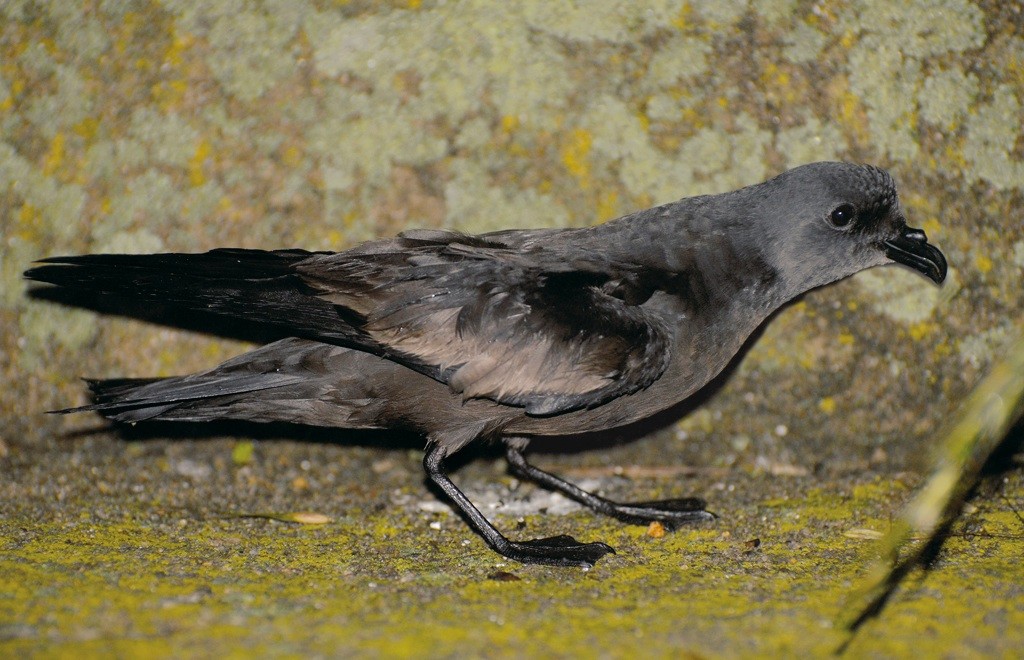
Swinhoe’s Storm Petrel Oceanodroma monorhis, Chilbaldo, South Korea, 21 June 2007 (René Pop). At night, beside stairway.
Most of the breeding distribution of Swinhoe’s Storm Petrel is relatively close to the Asian continent. The largest colonies are situated around the perimeter of shallow seas: the Yellow Sea and the South China Sea. Others are found on the continental side of Japan and around the Sea of Japan. In contrast, Leach’s Storm Petrels in the western Pacific region all breed close to deep sea trenches, on the Pacific side of Japan, and on islands off Kamtchatka, Russia, and in the Aleutian chain. In the eastern Atlantic too, colonies of Leach’s are as close to the edge of the continental shelf as they can be, which is necessary because during the breeding season, Leach’s feed mainly on zooplankton, which is most abundant over deep water (Mitchell et al 2004).
Swinhoe’s Storm Petrel’s more continental existence may also be hinted at by its dark ‘rump’. Ainley (1980) studied variation in Leach’s Storm Petrels along the western coast of North America. He noted that in areas where there was a high percentage of dark-rumped Leach’s, three other species of dark-rumped storm petrel nested alongside them: Black Storm Petrel O melania, Ashy Storm Petrel O homochroa and Least Storm Petrel O microsoma. Spear & Ainley (2007) also noted that in the Eastern Pacific, dark-rumped storm petrels occur relatively near the coast throughout the year. Highest densities were observed over the continental shelf (0-200 m) and the continental slope (200-2000 m), whereas light-rumped Leach’s and Wedge-rumped Storm Petrels O tethys reached their highest densities over seas deeper than 2000 m.
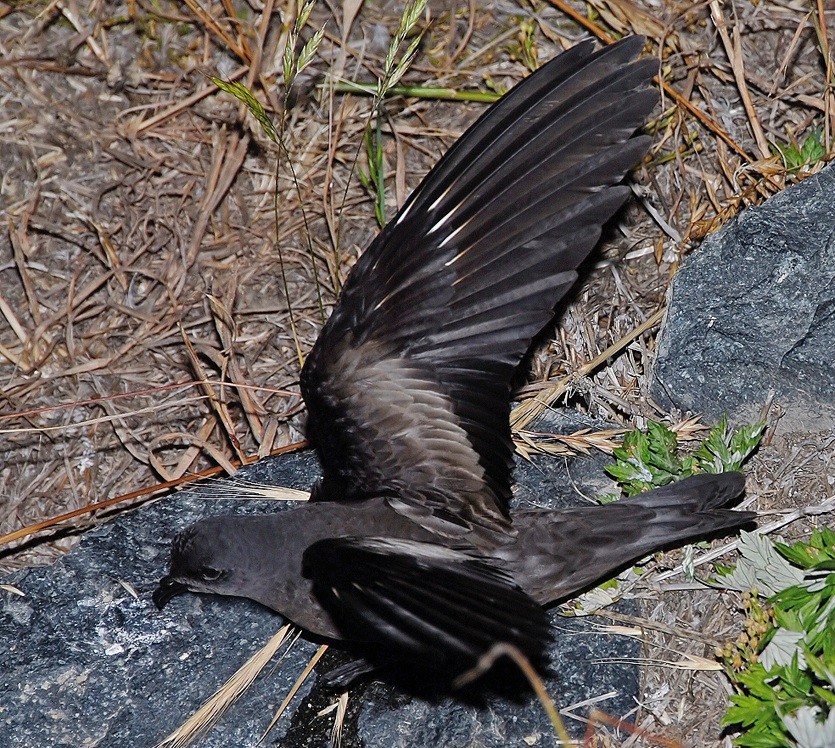
Swinhoe’s Storm Petrel Oceanodroma monorhis, Chilbaldo, South Korea, 20 June 2007 (Arnoud B van den Berg). At night, beside stairway.
Bretagnolle (1993) has argued that a white rump might make storm petrels more conspicuous to predators such as gulls, which are more numerous nearer to the coast. But Ainley (1980) thought that gull predation near coasts was no worse than skua predation out at sea. His preferred explanation for dark rumps in more continental storm petrels was that darker colour was in some way related to higher humidity, or at least more foggy and overcast conditions. During the Californian summer, such conditions occur more often close to land than over deeper offshore waters. Whether this is true or not, it brings us no closer to discovering the secret hiding place of Swinhoe’s Storm Petrel in the North Atlantic. Selvagem Grande, the only site where they have been suspected of breeding, is a tiny speck of land surrounded by deep, pelagic waters. Compared to Chilbaldo or the Californian islands, it is also a very dry place. Droughts of three years duration are not unknown. There is very little vegetation, and certainly no lush growth of sedges. However, Selvagem Grande does hold very large colonies of Madeiran and White-faced Storm Petrels.
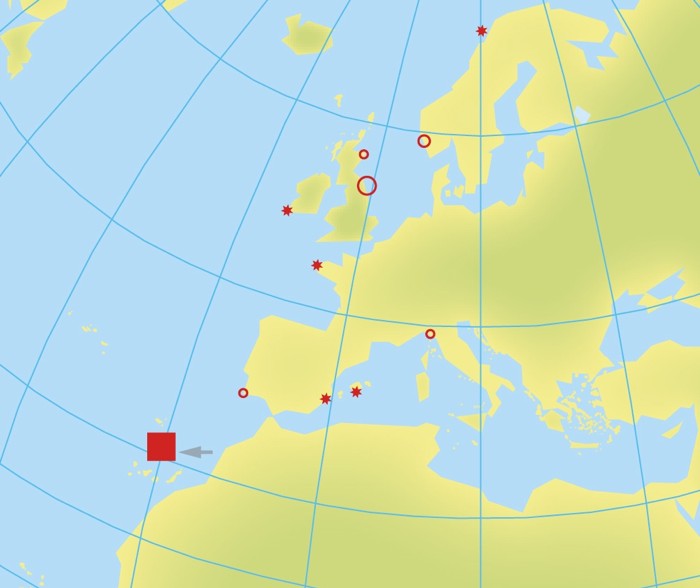
Swinhoe’s Storm Petrel Oceanodroma monorhis: trapped individuals. Recording location indicated by arrow:
Selvagem Grande, Selvagens.
Open circle: mist-netted away from storm petrel colonies
Stars: mist-netted in or near storm petrel colonies
Squares: individuals in suitable breeding habitat in storm petrel colony
In every other location where a Swinhoe’s Storm Petrel has been trapped, Hydrobates storm petrels are the common denominator. Five Swinhoe’s have even been trapped on islands where British or Mediterranean Storm Petrels H melitensis breed. Only a single Atlantic Swinhoe’s has been recorded in proximity to breeding Leach’s Storm Petrels (on Røst in Norway), but British breed there too. Morrison (1998) came up with a very plausible theory that might explain the link between British and Swinhoe’s. The winter range of Swinhoe’s in the Indian Ocean is known to extend as far south-west as Madagascar, bringing them within range of the warm Agulhas Current. This is a very swift and narrow current that transports warm water from the Indian Ocean towards the tip of South Africa. It travels as far as the Agulhas Bank, where it smacks into currents carrying cold water from the south-west. The meeting of these currents fuels the nutrient cycle for marine life, and the Agulhas Bank is known as the best fishing ground off South Africa. Where the currents collide, the Agulhas starts to curl anticlockwise, back towards the east, but not without shedding huge eddies, which take about 20% of its warm waters into the cold South Atlantic (Gordon 1985). Any Swinhoe’s following this warm water will soon come into contact with British Storm Petrels, and by migrating north with them, may end up in the North Atlantic.
For this reason, I suspect that one of the best places to look for Swinhoe’s Storm Petrels would be a large colony of British Storm Petrels. The southernmost colonies of this species are in the Canary Islands, and one or two Swinhoe’s could easily be hiding there, where very few people have searched. Madeiran Storm Petrels are very scarce in the Canaries, and Grant’s Storm Petrels do not arrive until August, so colonies there may have the advantage for Swinhoe’s that there is no competition for similar-sized nest-holes in summer. Further north, Swinhoe’s may well visit, and could conceivably breed among large colonies of British off the coasts of Britain, France, Ireland and northern Spain. The key to finding them will be to know their sounds, and I suspect, to search for them in mid- to late July.
I hope I will never be cured of my addiction to petrels, listening and puzzling while totally immersed in their world. Visiting petrel colonies will always be both a privilege and an adventure. Despite listening for them in storm petrel colonies from Iceland to the Cape Verde Islands, I have never been lucky enough to find a Swinhoe’s Storm Petrel, but I have not given up hope. I must confess to having felt more than a little envy when Arnoud and René visited the colony in South Korea, but I would rather find my first Swinhoe’s in a colony in the North Atlantic.
A month after their trip to Chilbaldo, I was due to visit to one of Scotland’s largest storm petrel colonies in St Kilda, where I dreamed that I might strike gold. St Kilda certainly proved to be an auspicious place for my father Norman, who had invited me along on the trip. In the preface, I told you that my parents met on Hirta in 1964. Remarkably, my father met his second wife Valerie at the same time. Valerie and her first husband Barry Morris also took part in the restoration of the village that summer, and the two couples became great friends. My sisters and I loved visiting ‘Auntie Valerie’ and ‘Uncle Barry’ when we were children. Barry died in 1986, and when my mother died not long afterwards, the friendship between my father and Valerie deepened. They married a few years later.
Despite good timing (22-24 July), favourable weather and wonderful experiences with four other petrel species, recounted in previous chapters, St Kilda did not prove to be Treasure Island for me. During my visits to the Carn Mór colony, there was no sign of a Swinhoe’s Storm Petrel. This is not to deny that a Swinhoe’s could be there. I only explored the colony for two nights, and could easily have missed a single bird away on a long foraging trip. Nor is this colony St Kilda’s largest. In 1999- 2000, Carn Mór held less than 10% of the Leach’s Storm Petrels in St Kilda, and only about a third of its British Storm Petrels.
St Kilda may not be the best place to look for Swinhoe’s Storm Petrels. Its very attractiveness to Leach’s Storm Petrels is likely to be a problem. Perhaps Swinhoe’s can only gain a toehold where this slightly larger and much more numerous competitor is absent. The abundance of the more northerly Leach’s in St Kilda also suggests that the seas near the archipelago may simply be a couple of degrees too cold. In Kerry, Ireland, further to the south, there are huge colonies of the smaller British Storm Petrel, without any larger competitors. I think that’s where I’ll try next.

